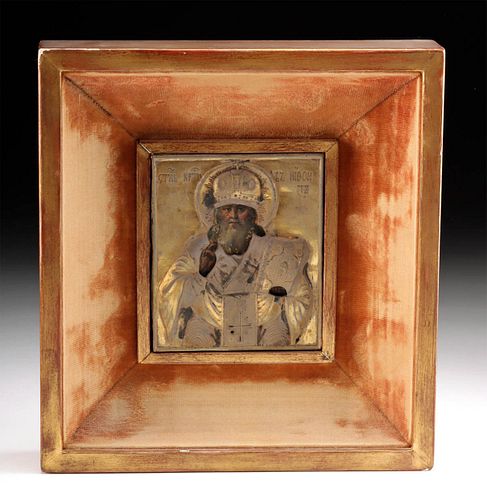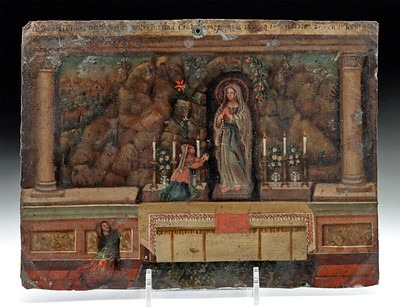19th C. Russian Gilt Silver Oklad Icon, Saint Nicholas
Lot 181
About Seller
Artemis Gallery
686 S Taylor Ave, Ste 106
Louisville, CO 80027
United States
Selling antiquities, ancient and ethnographic art online since 1993, Artemis Gallery specializes in Classical Antiquities (Egyptian, Greek, Roman, Near Eastern), Asian, Pre-Columbian, African / Tribal / Oceanographic art. Our extensive inventory includes pottery, stone, metal, wood, glass and textil...Read more
Estimate:
$1,200 - $1,800
Absentee vs Live bid
Two ways to bid:
- Leave a max absentee bid and the platform will bid on your behalf up to your maximum bid during the live auction.
- Bid live during the auction and your bids will be submitted real-time to the auctioneer.
Bid Increments
| Price | Bid Increment |
|---|---|
| $0 | $25 |
| $300 | $50 |
| $1,000 | $100 |
| $2,000 | $250 |
| $5,000 | $500 |
| $10,000 | $1,000 |
| $20,000 | $2,500 |
| $50,000 | $5,000 |
| $100,000 | $10,000 |
| $200,000 | $20,000 |
About Auction
By Artemis Gallery
Jun 15, 2023
Set Reminder
2023-06-15 10:00:00
2023-06-15 10:00:00
America/New_York
Bidsquare
Bidsquare : VARIETY Ancient, Ethno, Native American, Fine Art
https://www.bidsquare.com/auctions/artemis-gallery/variety-ancient-ethno-native-american-fine-art-12990
Antiquities, ethnographic, native american and fine art from cultures encompassing the globe. Artemis Gallery info@artemisgallery.com
Antiquities, ethnographic, native american and fine art from cultures encompassing the globe. Artemis Gallery info@artemisgallery.com
- Lot Description
Eastern Europe, Russia, ca. 19th century CE. Finely delineated in egg tempera and gesso on wood, an icon depicting the miracle-working St. Nicholas the Wonderworker, the most widely revered saint in Eastern Orthodox Christianity, fitted with a beautiful, gilded silver oklad. Believed to possess special powers to protect the faithful, this archetypal Bishop and Saint is dressed in sumptuous episcopal vestments, with a cross adorned omophorion, giving benediction with his right hand, and holding a Gospel in his left. St. Nicholas' golden crown and halo as well as his vestments and Gospel are meticulously detailed - note the Russian cross adorning the Gospel, the jewels on his crown, and the cascading folds of his robe. Size of oklad: 3.6" W x 4.1" H (9.1 cm x 10.4 cm); of frame: 8.25" W x 9" H (21 cm x 22.9 cm)
Nicholas, a Greek bishop of Myra, Anatolia in the 4th century and one of the most beloved saints of the church, who served as an intercessor, performing miracles of healing and rescue, has an interesting history. A strong opponent of the heretical bishop Arius at the Council of Nicaea, Nicholas, after slapping Arius in the face, was denied his holy insignia and tossed in jail. However, Christ and the Virgin appeared to him and gave him back his freedom and his episcopal office. Here shown with a serious countenance, a high furrowed forehead, concentrating eyes framed by arched brows, and a short, gray beard, Saint Nicholas is portrayed as a staunch champion of the Christian faith, a defender against heresy, and a healer.
The oklad (also spelled oclad) or riza, sometimes referred to as a revetment in English, is a metal cover that not only protects the icon, but also serves to honor or venerate the figure(s) depicted on the icon. Oklads are usually adorned with skillfully cut, engraved, and/or repousse work and pierced to reveal elements of the underlying painting.
Icons (icon means "image" in Greek) are sacred objects within the Eastern Orthodox Christian tradition. Found in homes as well as churches, these painted images depict holy persons and saints as well as illustrate scenes from the Scriptures. Icons are not worshiped, but are instead venerated for their ability to focus the power of an individual's prayer to God. As a focus for prayers and meditation for believers, icons serve as "windows into heaven."
Provenance: private Rancho Mirage, California, USA collection, by inheritance in 2020; ex-Dr. TDR Berreth, California, USA, acquired before 1982
All items legal to buy/sell under U.S. Statute covering cultural patrimony Code 2600, CHAPTER 14, and are guaranteed to be as described or your money back.
A Certificate of Authenticity will accompany all winning bids.
We ship worldwide and handle all shipping in-house for your convenience.
#179108Some light scratches and abrasions to oklad and minor chipping to pigments. Otherwise, intact and very nice with great remaining pigments and rich patina in areas. Fit in modern velvet matte and wood frame with areas of loss to velvet, nicks to wood frame, and tearing to gallery paper on verso. Suspension wire on verso for display.Condition
- Shipping Info
-
All shipping is handled in-house for your convenience. Your invoice from Artemis Gallery will include shipping calculation instructions. If in doubt, please inquire BEFORE bidding for estimated shipping costs for individual items.
-
- Buyer's Premium



 EUR
EUR CAD
CAD AUD
AUD GBP
GBP MXN
MXN HKD
HKD CNY
CNY MYR
MYR SEK
SEK SGD
SGD CHF
CHF THB
THB













